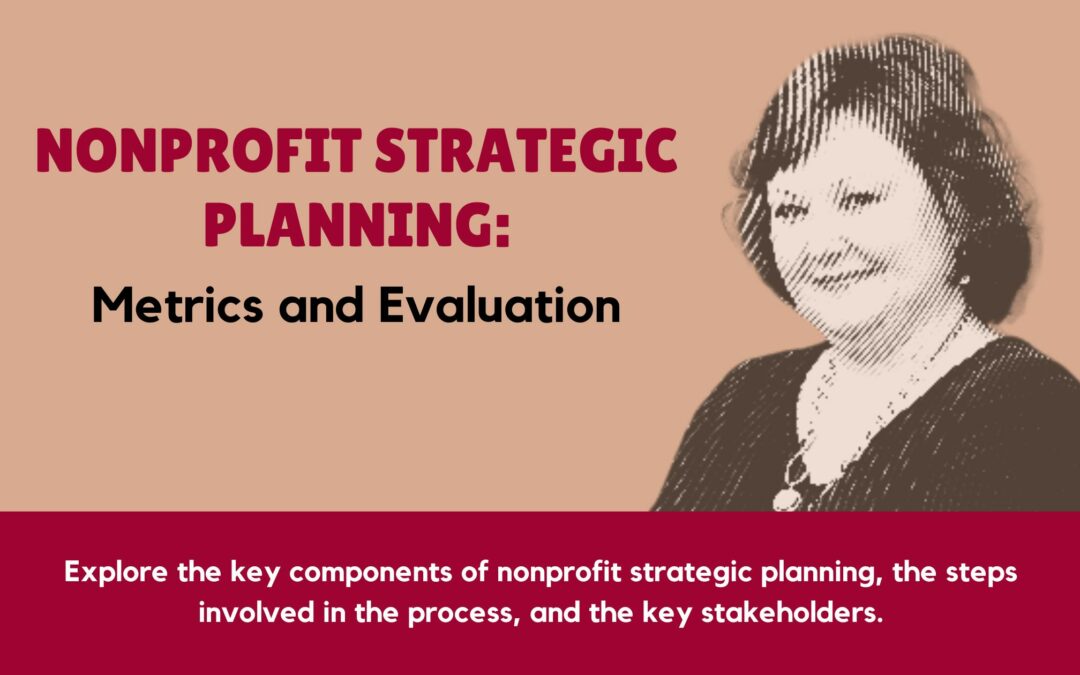Nonprofit Strategic Planning: Metrics and Evaluation
Strategic planning is critical for nonprofit organizations, providing a roadmap for success and impact. By setting clear goals, objectives, and action plans, nonprofits can prioritize initiatives, allocate resources, and monitor organizational performance. In this blog, we will explore the key components of nonprofit strategic planning, the steps involved in the process, and the key stakeholders. We will also discuss the importance of performance measures and evaluation in strategic planning and the challenges nonprofits may face along the way. Through a case study, we will highlight the impact of effective strategic planning and draw key learnings for nonprofit leaders. So, let’s dive into nonprofit strategic planning, where metrics and evaluation are key to organizational success.
Understanding Nonprofit Strategic Planning

Nonprofit strategic planning is a process that enables organizations to define their mission, vision, goals, and objectives, and create action plans to achieve them. It provides a framework for aligning organizational activities with strategic goals, ensuring effective resource management, and driving impact. By taking a proactive approach to strategic planning, nonprofits can navigate challenges, identify new opportunities, and plan for long-term success.
Importance of Strategic Planning for Nonprofits
Strategic planning plays a crucial role in nonprofit organizations, offering several key benefits:
- Prioritizing initiatives effectively: With limited resources, nonprofit strategic planning helps organizations allocate their time, energy, and funds towards activities that will have the most impact. By setting clear goals and objectives, strategic planning ensures that nonprofit leaders can make informed decisions about where to invest their resources.
- Providing a framework for monitoring and evaluation: Performance indicators, KPIs, and evaluation processes are integrated into strategic planning, allowing nonprofits to assess their progress towards organizational goals. Monitoring organizational performance helps leaders identify areas that need improvement, make strategic adjustments, and ensure ongoing success.
- Effective resource allocation and management: Nonprofit strategic planning helps organizations plan for the effective management of their resources, including time, finances, and personnel. By aligning activities with strategic goals, leaders can optimize resource allocation, ensuring that organizational activities are aligned with mission-driven objectives.
- Identifying new opportunities and planning for future success: Strategic planning enables nonprofit leaders to anticipate and plan for future opportunities, challenges, and changes in the nonprofit landscape. By taking a proactive approach, leaders can position their organization for success, ensuring long-term impact and sustainability.
- Enhancing organizational resilience and impact: A strategic plan provides nonprofit organizations with clarity, direction, and focus. It enables leaders to navigate challenges, adapt to changing circumstances, and remain resilient in the face of adversity. By aligning activities with strategic goals, nonprofits can maximize their impact and effectively serve their mission.
Key Components of Nonprofit Strategic Planning

Nonprofit strategic planning encompasses several key components, including vision, mission, goals, objectives, action plans, and evaluation processes. Let’s explore these components in more detail:
- Vision and mission statement: The vision statement outlines the organization’s long-term aspirations, while the mission statement defines its purpose and reason for existence. These statements provide nonprofit leaders, staff, and stakeholders with a clear understanding of the organization’s goals and objectives, guiding strategic decision-making.
- SWOT analysis: Strategic planning involves conducting a SWOT analysis, which stands for strengths, weaknesses, opportunities, and threats. This analysis helps nonprofit leaders identify internal strengths and weaknesses, as well as external opportunities and threats, providing insights for strategic planning activities.
- Performance indicators and monitoring: Strategic planning integrates performance indicators, KPIs, and monitoring processes to assess organizational performance. By tracking key metrics, nonprofit leaders can evaluate progress towards strategic goals, identify areas for improvement, and make data-driven decisions.
- Evaluation process: An evaluation process is an essential component of nonprofit strategic planning, allowing leaders to measure the impact and effectiveness of organizational activities. By evaluating performance, leaders can identify opportunities for growth, refine strategic plans, and enhance organizational performance.
- Alignment with strategic goals: Nonprofit strategic planning ensures that all organizational activities, programs, and initiatives are aligned with strategic goals. This alignment helps nonprofit leaders direct resources, time, and energy towards activities that support mission-driven objectives, maximizing impact and effectiveness. By incorporating these key components, nonprofit strategic planning provides a comprehensive framework for organizational success, performance evaluation, and impact measurement.
Steps Involved in Nonprofit Strategic Planning

Strategic planning for nonprofits is a process that involves several key steps. Let’s explore each step in detail:
Defining Mission and Vision
The mission and vision statements of a nonprofit organization are critical in developing a strategic plan. The mission statement describes the fundamental purpose of the organization, while the vision statement outlines its long-term goals and aspirations. By defining these statements, nonprofit leaders, staff, and stakeholders get a clear understanding of the direction that the organization wants to take. This clarity can guide strategic decision-making and action planning.
Crafting a compelling mission and vision statement requires careful consideration and input from all stakeholders involved. It is essential to ensure that these statements align with the values of the organization and resonate with its supporters. A well-articulated mission statement can motivate employees, attract volunteers, engage donors, and help build a strong brand identity for the organization.
Once developed, it is crucial to review these statements regularly to ensure they remain relevant and aligned with organizational goals. As nonprofits evolve over time, their missions and visions may change as well. Thus, updating these statements can help ensure that everyone involved remains focused on achieving shared objectives.
In conclusion, nonprofit organizations must create clear mission and vision statements as a foundation for strategic planning. These statements provide direction for decision-making and action planning while engaging stakeholders in fulfilling their goals. Regular review ensures that these statements remain relevant over time as organizations continue to evolve.
Conducting a Comprehensive Assessment
A comprehensive assessment of the organization’s current state is crucial in strategic planning. This assessment involves evaluating both internal and external factors that impact organizational performance, such as organizational culture, resources, competitive landscape, and market trends. By conducting a thorough assessment, nonprofit leaders can identify strengths, areas for improvement, strategic issues, risks, and opportunities, providing a foundation for effective strategic planning decisions.
Forecasting and Setting Organizational Direction
Forecasting involves predicting future trends, challenges, and opportunities that may impact the nonprofit organization. Setting organizational direction aligns activities with strategic goals, ensuring that the organization is prepared to navigate changes and achieve its mission. During this step, nonprofit leaders create a time frame for achieving strategic objectives and goals, fostering clarity, focus, and alignment within the organization.
Creating Strategic Objectives
Strategic objectives are specific, measurable goals that support the mission and vision of the nonprofit organization. These objectives provide a roadmap for achieving the organization’s long-term aspirations, guiding strategic decision-making, resource allocation, and action planning. By setting strategic objectives, nonprofit leaders can align organizational activities, measure progress, and drive impact.
Role of Key Stakeholders in Strategic Planning

Stakeholders play a crucial role in nonprofit strategic planning, providing valuable input, support, and accountability. Let’s explore the key aspects of stakeholder involvement:
Aligning with Stakeholders
Aligning strategic planning activities with key stakeholders ensures that the strategic plan meets their needs, expectations, and goals. Nonprofit leaders communicate the impact of the strategic plan on stakeholders, fostering trust, transparency, and accountability. By integrating stakeholder feedback, leaders can refine and enhance the strategic plan, ensuring alignment with organizational goals.
Stakeholder Engagement in Strategy Mapping
Engaging key stakeholders in strategy mapping enhances strategic planning activities. Stakeholder input provides valuable insights, perspectives, and expertise, improving the quality and impact of strategic plans. Involving stakeholders fosters a sense of ownership, commitment, and buy-in, creating a collaborative environment for strategy development and execution. By actively engaging stakeholders, nonprofit leaders promote organizational transparency, inclusivity, and effective decision-making.
Determining Strategic Initiatives

Determining strategic initiatives is a key step in nonprofit strategic planning, as it involves defining specific, measurable goals and action plans. Let’s delve deeper into this process:
How to Set Initiatives
Setting strategic initiatives involves defining clear goals and action plans that align with the nonprofit organization’s vision, mission, and strategic objectives. These initiatives should be specific, measurable, achievable, relevant, and time-bound, guiding organizational activities, performance monitoring, and evaluation. By setting initiatives, nonprofit leaders foster strategic alignment, accountability, and effective resource management.
Prioritizing Initiatives
Prioritizing strategic initiatives is essential to ensure effective resource allocation, goal attainment, and strategy execution. Nonprofit leaders evaluate the impact and feasibility of initiatives, considering factors such as organizational capacity, mission alignment, and strategic goals. By prioritizing initiatives, leaders focus organizational efforts on activities that will have the most impact, ensuring effective strategy execution and organizational success.
Performance Measures and Analysis in Strategic Planning

Performance measures and analysis are key components of nonprofit strategic planning, enabling leaders to evaluate organizational performance, measure impact, and make data-driven decisions. Let’s explore this further:
Benchmarking Performance Measures
Benchmarking performance measures involves comparing organizational performance against industry standards, best practices, or key competitors. This process helps nonprofit leaders identify opportunities for improvement, measure progress, and set realistic performance targets. By utilizing benchmark data, leaders can make informed strategic management decisions, enhancing organizational performance and impact.
Evaluating Performance
Evaluating organizational performance is essential for nonprofit strategic planning, as it provides leaders with insights into the organization’s effectiveness, efficiency, and impact. Through ongoing performance evaluation, leaders identify areas for development, strategic planning adjustments, and performance improvement. By leveraging data-driven evaluation, nonprofit leaders make informed decisions, driving organizational success and mission impact.
Prioritizing the Strategic Planning Process

Prioritization is key to effective nonprofit strategic planning, ensuring that activities, goals, objectives, and action plans align with organizational goals. Let’s explore the importance of prioritization in strategic planning and techniques for effective prioritization:
Importance of Prioritization in Strategic Planning
Prioritization ensures effective strategic planning by focusing organizational efforts, resources, and time on key strategic objectives. By prioritizing activities, leaders optimize resource utilization, enhance organizational agility, and drive impact. Prioritization fosters strategic alignment, goal attainment, and effective strategy execution, ensuring organizational success, impact, and mission fulfillment.
Techniques for Prioritization
Effective prioritization techniques support nonprofit strategic planning activities, ensuring that goals, objectives, and action plans align with organizational goals. Techniques for effective prioritization include impact and feasibility analysis, value proposition analysis, SWOT analysis, strategic framework analysis, and strategic planning cycles analysis. By employing these techniques, nonprofit leaders can make informed strategic planning decisions, align activities with strategic goals, and maximize impact.
Challenges in Nonprofit Strategic Planning

Nonprofit strategic planning can present challenges, requiring leaders to navigate obstacles, manage expectations, and overcome barriers. Let’s explore common challenges faced by nonprofit organizations:
Common Challenges
Limited resources and funding impact nonprofit strategic planning cycles, requiring leaders to make strategic decisions around resource allocation, time management, and organizational capacity. Aligning strategic objectives with the organization’s mission statement can be a common obstacle, necessitating effective communication, collaboration, and stakeholder engagement. Difficulty in monitoring and evaluation can hinder the strategic management process, requiring leaders to implement ongoing evaluation processes and performance indicators. Resistance from team members or stakeholders often presents challenges in strategic planning, necessitating effective change management, communication, and organizational development strategies. Identifying new opportunities and competitive advantage can be a hurdle for nonprofit organizations, requiring leaders to proactively seek strategic opportunities, conduct market analysis, and foster innovation.
Overcoming Challenges
Nonprofits can overcome strategic planning challenges through effective planning activities, stakeholder engagement, performance evaluation, and ongoing organizational development. By addressing resource limitations, leaders can optimize resource utilization, explore partnerships, and diversify funding sources. Aligning strategic objectives with the organization’s mission statement requires open communication, collaboration, and ongoing strategic planning activities. Monitoring and evaluation challenges can be addressed through ongoing process improvement, performance indicators, and data-driven evaluation. Engaging team members and stakeholders fosters support, ownership, and commitment to strategic planning initiatives. Identifying new opportunities and competitive advantage demands proactive strategic planning, ongoing market analysis, and organizational agility.
Case Study of Successful Nonprofit Strategic Planning
To illustrate the impact of effective nonprofit strategic planning, let’s explore a case study of a fictional organization that has successfully implemented strategic planning activities:
Organization Profile
ABC nonprofit organization is a leading nonprofit organization that focuses on providing educational opportunities for underprivileged children. Their strategic framework aligns their vision statement, “Empowering every child with education,” with strategic objectives, key results, and action plans. The nonprofit organization has implemented effective strategy execution, reflected in their performance indicators, balanced scorecard methodology, and performance monitoring processes. Their business strategy and strategic management process demonstrate effective strategic planning, ensuring organizational impact, mission fulfillment, and sustainability. ABC nonprofit organization consists of business units that operate at functional levels, integrating their activities with strategic goals, objectives, and action plans.
What can we learn from their strategic planning process?
By analyzing the strategic planning process of ABC nonprofit organization, nonprofit leaders can draw key learnings for effective strategic planning:
- Align strategic objectives with the organization’s mission statement: Aligning strategic objectives with the organization’s mission statement ensures that organizational activities are mission-driven, impactful, and effective. This alignment fosters strategic planning that drives mission impact, organizational success, and stakeholder satisfaction.
- Improve monitoring and evaluation processes: Ongoing monitoring and evaluation are essential for organizational performance improvement, impact measurement, and strategy refinement. By implementing effective monitoring and evaluation processes, nonprofit leaders can make data-driven decisions, identify improvement opportunities, and enhance organizational performance.
- Overcome resistance from team members or stakeholders: Overcoming resistance to strategic planning requires effective change management, communication, and organizational development strategies. By engaging team members and stakeholders, leaders can foster support, ownership, and commitment, ensuring effective strategy execution and organizational success.
- Identify new opportunities and competitive advantage: Nonprofit leaders must proactively seek new opportunities, conduct market analysis, and foster innovation. Identifying new opportunities and competitive advantage ensures organizational growth, impact, and mission fulfillment.
- Address crisis management and strategic issues resolution: Effective strategic planning involves crisis management, strategic issues resolution, and ongoing organizational development. By anticipating strategic issues, nonprofit leaders can plan strategic responses, foster organizational resilience, and navigate challenges effectively.
Conclusion
Nonprofit strategic planning is crucial for the success and sustainability of organizations dedicated to making a positive impact. By following a systematic approach and involving key stakeholders, nonprofits can define their mission, assess their current state, set objectives, and determine strategic initiatives. However, it is equally important to prioritize the strategic planning process and overcome challenges that may arise along the way.
Measuring performance and evaluating the effectiveness of strategic initiatives is essential for continuous improvement. Benchmarking performance measures and analyzing data allow nonprofits to identify areas of strength and areas that require improvement.
In conclusion, nonprofit strategic planning requires careful consideration, collaboration, and evaluation. By prioritizing the process and addressing challenges head-on, organizations can create a roadmap for success and ensure their efforts align with their mission and vision. Together, we can create a stronger and more impactful nonprofit sector.
